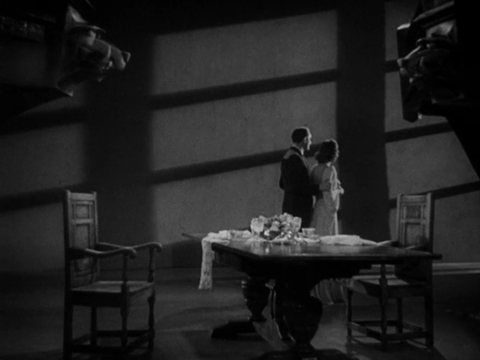Many modern horror films work their asses off to justify surreal images, saving the most perverse sights for dream sequences and climaxes. They want to begin at familiar and graduate their style. This makes some sense. By opening in a plausible world, the films make it easier for viewers to identify with the story. However, this can sometimes be limiting, and one of the coolest things about early horror films is that they're unapologetically nightmarish. They immediately dive into the deep end. At its very best, Son of Frankenstein recognizes the pleasure that can come from such bold choices.
Some background: Son of Frankenstein, in a shell of nut, centers on Wolf Frankenstein (Basil Rathbone) re-starting the family business of re-animating Boris Karloff (or rather, re-re-animating him). However, Wolf attends to this more out of duty than passion - Rathbone's performance lacks the buried mania of Colin Clive's work in the first two films. "Now I know what it feels like to be God!" shouted Victor in the original, and, by comparison, Rathbone feels too upright and steady. It further confuses matters that much drama comes from Ygor (Bela Lugosi), who wants to kill the jurors who voted to hang him and enlists the Monster to do his dirty work. Lugosi's performance is a nice bit of scenery-chewing, but it upstages Karloff's Monster. Still, the movie's story works, and the images often look good. If someone forced me to letter-grade the film, it'd get a B-. The biggest factor that keeps me from loving it more is the stagy presentation of the material.
The first Frankenstein movie was based on a stage play, like many horror films of its day - other stage-to-screen adaptations include Paul Leni's The Cat and the Canary, Tod Browning's Dracula, and Rouben Mamoulian's Dr. Jekyll and Mr. Hyde. However, despite the connection to the controlled, distant viewing that comes with watching a stage play, Whale's adaptation (and its sequel) feel cinematic. Two examples. The first Frankenstein has a haunting scene where the camera tracks along with a man carrying his dead daughter through a bustling town square. The second Frankenstein has its unforgettable sequence of Frankenstein and Dr. Pretorious (Ernest Thesiger) igniting the Bride.
Seen in quick, stark, shadowed, angled close-ups, Whale cuts from crazy angles of the mad scientists to close-up electrical snaps and sizzles. It's disorienting and vivid and unforgettable. Meanwhile, Son of Frankenstein, despite being material written for the screen, often looks like someone put a camera at the back of a theater and hit "record."
The film is almost stubborn in how it keeps its distance, how it almost never moves the camera during a shot, and how it almost always relies on in-camera details like lighting and (especially) setting to communicate the mood. None of this would be frustrating without the previous two movies being so damned dynamic.
This is not to say the film can't evoke mood or atmosphere. At times, the size of the surroundings makes the characters feel small, overwhelmed by their environment. Rathbone and co-star Josephine Hutchinson, spend much of their time navigating creepy, expressionist sets. Check out the not-quite symmetry of this dinner scene. How the gargoyles and chairs line up evenly, and how the placement of the characters and the angled shadows suggests imbalance. The imbalance makes sense: they're looking at the remains of the old laboratory.
There are also scenes that show what more involved staging can accomplish. One effective scene has Wolf reassuring his wife that he isn't responsible for any of the local murders. Behind him, behind her, lording over them, a portrait of Colin Clive's Victor from the previous two films.
That's a damned clever way to show how the legacy of Victor towers over Wolf...and to firm up the continuity. There are other, subtler efforts along those lines, most notably an effective creep-out in the lab. As Wolf looks over equipment, the Monster crawls out of a hole and stalks toward him.
The composition, the duration of the shot, and the effortless suspense (will he attack?) plays like a deliberate echo of a scene from the original Frankenstein.
Which was itself an intentional echo of an infamous scene from The Cabinet of Dr. Caligari.
Scenes like those showcase a genuine interest in the style of the previous films, and, no doubt, Son of Frankenstein look great, occasionally stunning, full of that nightmarish confidence mentioned earlier. I just wish the craftsmen who put those settings on the screen took the time to explore them with more energy, with a freer camera and a stronger sense of how the presentation of those spaces is as important as the spaces themselves.







No comments:
Post a Comment